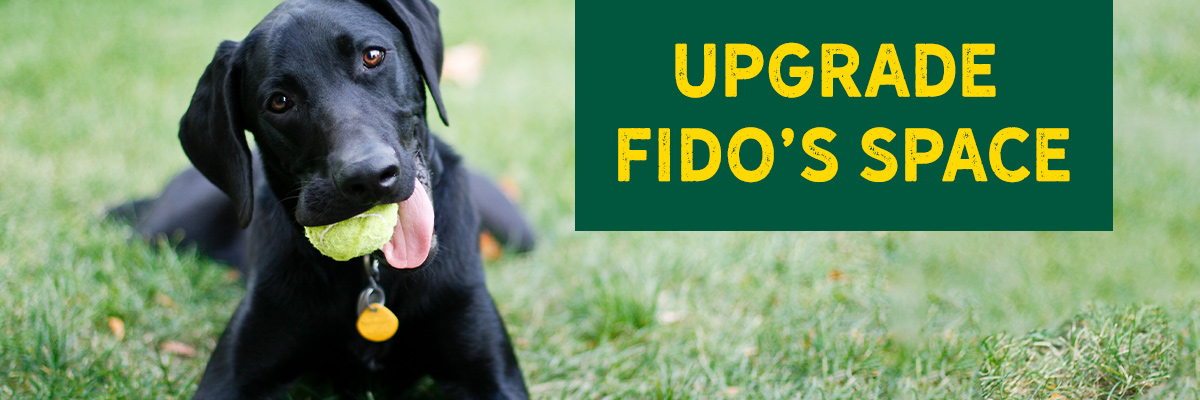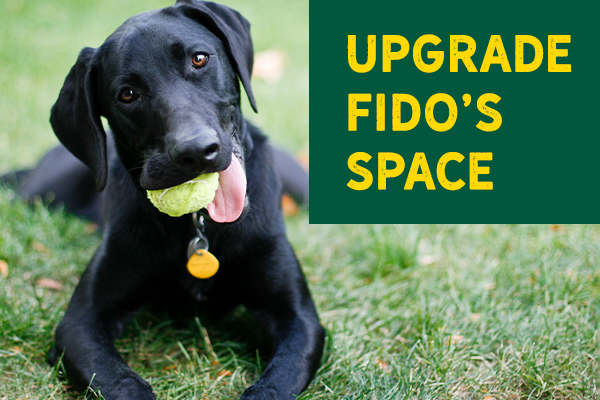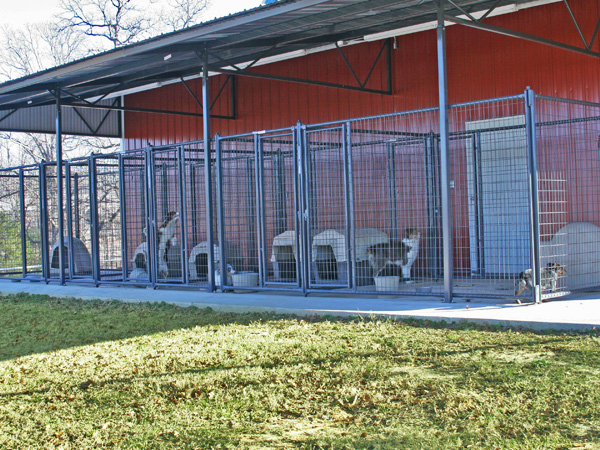

Design Your Own Outdoor Dog Kennel
Whether you need a safe outdoor space for your energetic puppy or your hunting buddy, an outdoor dog kennel will give them their own place to go potty, play, nap, or just an area where they can’t get into trouble and can be happy when you’re not free to play fetch. Building a dog kennel yourself means that you can design it to fit your dog’s needs. Run through our checklist to be sure you have what you need to make your dog safe and comfortable.
Designing Your Dog's Kennel
Different dogs and families have different needs when deciding on an outdoor kennel. Do you have neighbors that could be disturbed by barking? How will “kennel time” fit into your routine? Before you build, decide if an outdoor dog kennel is a good fit for you and your dog.

After that, it’s time to think about building (always the best part!). Before you get out the wrench, there are several things to consider:
-
Space and Location- Location for any home is important. While your dog is in their kennel, it’s their home and should be considered as such. There should be plenty of space allocated for play, sleep, and potty. The size will depend on how big your dog is (or expected to be) and their activity level. A chihuahua will need less space than a Great Dane, but a happy border collie might need the biggest space. Many dog kennel panels are expandable, so if you decide you need more room later it’s an easy addition.
After you have decided on a good starting size, decide where the door will be. You should have easy access to the door and there should be nothing impeding its ability to open fully and quickly. The kennel itself should also be in a location that can be accessed quickly and on a level spot of ground, and you should have a clear view to keep an eye on your dog. However, some space between your home or where you spend time in your backyard (like your deck) will help keep the smell of urine away and help quiet the sound of any barking. Make sure the kennel is away from garden beds or plants to avoid any curious nibbles through the kennel.
-
Flooring- Depending on what you have in your backyard or on your land, your options might be different, and you can work with what you have. Panel kennels are designed to stand on their own and don’t need dirt to be secured into, however some chain link panels have posts that will need to be in the ground.
The best “floor” for your dog is something that can be easily cleaned. Concrete can be good if it’s in a shaded area as it can get hot during the day. Pea gravel is a good option as it can be easy to clean and doesn’t absorb heat as much as concrete. If you choose gravel (or a different option) it is best to have good drainage- a muddy kennel isn’t fun. A note for gravel or concrete: add a comfy bed inside for naptime. Other options that require extra building are wood or composite wood flooring, but be sure to include good drainage.

Grass can be difficult as you might have urine smells from a concentrated area, and you would have to figure out how to mow the grass inside the kennel. Grass and dirt can also be dug into by your dog and it's possible your dog could tunnel its way out. If you like the look of grass, look into the option of pet turf. Speaking of cleaning, a water source like a garden hose near the kennel is a great idea for easy cleanup and drinking water.
-
Materials- For these larger outdoor kennels, we aren’t talking about your classic wood dog house (although one could certainly fit inside as a comfy sleeping place). We are talking about either chain link (like chain link fencing) or welded wire. These metal options allow your dog to have a large enough space outside to enjoy movement.
Chain link panels are a more economical option and easy to install. If using chain link, be sure the chain is inside the kennel instead of installed outside to add more durability in case your dog decides to push on or inspect the wire. Welded wire panels are more secure as the wire is powder-coated to resist rust and welded for added durability. Both materials will have the option to add in extra panels inside the kennel if you need to separate dogs. -
Roofing- A roof is generally recommended to keep your dog contained and shaded. The squares or spaces in a metal kennel can be climbed on, so to avoid a dog jumping out another panel of the same material can be installed as a roof. A sun shield can be added on top to help keep your dog cool. A sun shield can be used as a roof without an extra top panel. However, if your dog climbs, they could decide to chew through the fabric of the sun shield and escape. For the best security, both a metal wire panel and shield should be installed as a roof.
-
Security- Last, but not to be overlooked, is security. The kennel should be secure to properly contain your dog. Regularly inspect the wire panels to ensure they are sturdy and the door closes properly. If the kennel door that you purchase can swing open inward or outward, having it swing inward provides the best protection as there’s little room for your dog to escape between the door, side of the kennel, and you. Consider adding outdoor lighting near the kennel if your dog will be in there when it’s dark to better keep any eye on them.
Outdoor dog kennels are a great way to get your dog outside in a safe environment to play, potty, and nap. Welded wire or chain link panels give you the flexibility you need to design the kennel to best fit your space and your dog’s needs. Have questions on installation or different panel brands? Reach out to your local McCoy’s where we will be happy to discuss logistics with you. We never want to miss an opportunity to hang out with your pup, too.

